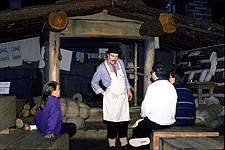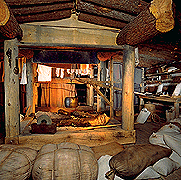Canada Hall
 The Timber Trade
The Timber Trade
In the early nineteenth century, a new industry emerged in the forests of eastern and central Canada. The Napoleonic wars created a tremendous demand for timber to build British warships; however, a blockade of French ships prevented England from buying wood from the Baltic states, which had previously been its main supplier. As a result, England turned to Canada, where a seemingly inexhaustible supply of wood was available. Lumber camps sprung up in the forests of the Maritimes and central Canada. The shanty house on display is a reconstruction of a typical structure used to house lumbermen in an early Ottawa Valley lumber camp.

When peace came to Europe, there was still a demand for timber. Up until 1830, North America produced primarily square logs because they were easier and safer to stow on ships bound for Europe than round logs. By mid-century, however, sawmills were producing more and more milled lumber, and not all of it was being exported overseas. Wood was needed for the shipbuilding industry, for urban development in Canada and the United States, and for the production of paper for the newspaper industry.
Between 1807 and 1880, most lumbermen working in central Canada were seasonal workers of Native, French Canadian, Irish, and Scottish background. Many were labourers, farmers, or factory workers seeking extra wages during the winter months. Life in the camps was hard, the work was strenuous and dangerous, and the men were away from their families for long periods during the dark winter months. While the men were away working in the bush, the women took care of house, barn and animals, doing the farm chores with the help of the older children. Needless to say, loneliness created numerous social problems. The men only returned home in the spring, when the timber floated downstream to sawmills and the timber drive was over.
Trees were cut almost exclusively during the winter months. There were several reasons for this: it was easier to fell trees when the sap was not running; it was easier to haul timber over the snow onto the ice roads; and there was always a surplus of cheap labour in the winter. Among the hazards of working in the woods were the danger of frostbite, the risk of being injured by falling trees or by axes, and the possibility of falling through river ice into frigid water.
 The caboose shanty on display is typical of those found in
nineteenth-century Ottawa Valley lumber camps. The shanty had a
central hearth with an opening in the roof for smoke ventilation.
The fire was never put out, since it was needed for cooking as
well as providing heat and light. Despite this, it was usually
bitterly cold in the cabin. To keep warm, the men doubled up in
their bunk beds. This situation improved in the late nineteenth
century, when cast-iron stoves replaced open hearths. A typical
shanty diet consisted of salt pork, baked beans, pea soup, lard,
and bread, supplemented by fish, partridge, hare or venison.
The caboose shanty on display is typical of those found in
nineteenth-century Ottawa Valley lumber camps. The shanty had a
central hearth with an opening in the roof for smoke ventilation.
The fire was never put out, since it was needed for cooking as
well as providing heat and light. Despite this, it was usually
bitterly cold in the cabin. To keep warm, the men doubled up in
their bunk beds. This situation improved in the late nineteenth
century, when cast-iron stoves replaced open hearths. A typical
shanty diet consisted of salt pork, baked beans, pea soup, lard,
and bread, supplemented by fish, partridge, hare or venison.
 Because of its widespread availability, versatility and ease of use,
wood was employed in virtually everything made -- from shoes, eating
utensils, furniture and houses to jewellery, ships, wagons and
weapons. Our ancestors developed specialized tools for the cutting,
shaping, joining and piercing of wood. They subsequently developed
measuring instruments, clamping devices and other auxiliary tools for
woodworking.
Because of its widespread availability, versatility and ease of use,
wood was employed in virtually everything made -- from shoes, eating
utensils, furniture and houses to jewellery, ships, wagons and
weapons. Our ancestors developed specialized tools for the cutting,
shaping, joining and piercing of wood. They subsequently developed
measuring instruments, clamping devices and other auxiliary tools for
woodworking.


